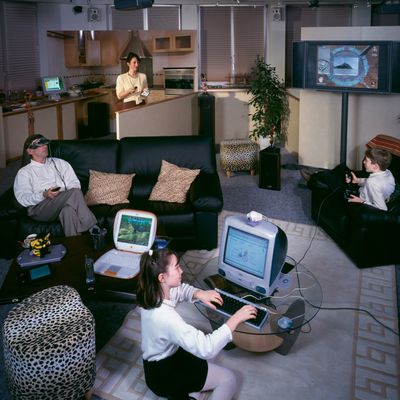
Bill Gates’s glass-and-recycled-Douglas-fir estate, Xanadu 2.0, completed in 1997, took seven years and $63 million to build, and came stuffed with smart-home tech years ahead of its time. In his 1995 book The Road Ahead, Gates outlined his ambitions. “First thing, as you come in, you’ll be presented with an electronic pin to clip to your clothes,” wrote Gates. The pin connected visitors to the house and its myriad services, from lighting and temperature to what news program to show on the many TVs spread around the home. “As you walk down a hallway, you might not notice the lights ahead of you gradually coming up to full brightness and the lights behind you fading.”
Music was similarly able to follow visitors. “It will seem to be everywhere,” wrote Gates, “although, in fact, other people in the house will be hearing entirely different music or nothing at all.” Servers running Windows NT kept hundreds of thousands of pieces of artwork to be thrown onto built-in high-definition monitors concealed behind wooden panels, personalized to each visitor. “It will seem to you as if the photographs are displayed everywhere, although actually the images will materialize on the walls of rooms just before you walk in and vanish after you leave.”
It cost hundreds of thousands of dollars for the servers and monitors alone, and much, much more to make everything work — of the 300 construction workers who labored on Gates’s home, 100 were electricians. Twenty years later, a $99 SmartThings hub and motion sensors, some smart light bulbs, a Nest thermostat, and a few Sonos speakers can replicate much of what Gates built, even if your own home lacks a domed library with a copy of da Vinci’s Codex Leicester.
Gates, of course, wasn’t the first to come up with the idea of a home that anticipates your needs and wants; he was just one of the first to have the cash and technophilia to make it into a reality. Ray Bradbury’s 1950 short story “There Will Come Soft Rains” had a cheery smart home puttering along making eggs and bacon for a family vaporized in a nuclear blast. Various automated concept homes percolated in the ’50s and ’60s, from Ford’s “1999 AD” home to Monsanto’s all-plastic, vaguely fungal “House of the Future.” In the 1970s, the X10 protocol was the first commercial standard to make those dream homes real, using the electrical wiring in a home to control lights and various home appliances for a niche customer base. In the 1980s, Oregon inventor Frances Gabe gained fame for her “self-cleaning home,” which used spray nozzles and air jets to turn her home into something like a livable washing machine. Even that ’90s infomercial hit the Clapper, seen through a certain lens, was just another smart-home gadget, allowing you to turn out the lights without getting out of bed. (Unlike many smart-lighting options, you didn’t even need to pull out a smartphone to use it.)
But what are we really dreaming of when we envision a smart home? For companies in the business of selling gadgets and appliances to you, the pitch is that a smart home will amplify what’s already pleasurable about being at home, and eliminate what’s onerous. For the potential smart-home customer, there’s the lure of a home that extends control and outsources some of the drudgery of maintaining a household, whether that’s vacuuming or remembering to turn off the lights.
Smart homes have been a wave that many have spent decades waiting to catch. The National Association of Home Builders formed its “Smart House” group in 1984. (It also tried and failed to get the term cybertecture into the lexicon.) Companies have risen and fallen waiting for smart homes to become anything close to mainstream. But in the last five years, smart homes have shifted from being purely the province of wealthy tech dorks to something an average homeowner or renter might consider.
You can chalk it up to a confluence of three things. Moore’s law has worked its usual logic on the price of processors and Bluetooth and Wi-Fi antennas, and anything that can be connected has been (even if the use case for, say, a Wi-Fi-enabled egg tray is hard to envision). The surprise success of Amazon’s Echo smart speaker and its imitators has made voice control in the home cheap and easy to implement. And continuing consolidation has allowed companies to start to bring more and more offerings under one ecosystem, whether that’s Google acquiring smart-home thermostat company Nest, Samsung snapping up SmartThings, or Amazon buying smart-doorbell manufacturer Ring.
There are still major barriers for widespread smart-home adoption to take place. Security is shaping up to be a headache, with connected devices often containing gaping security holes. Privacy will be a concern; a smart home that can track you and your family throws off a gut-churning amount of data, with little promise that manufacturers will secure that information (or, as happened with smart TVs a few years ago, won’t actively sell data to third parties to make a little extra income on the side). And at the most pragmatic level, the smart-home market remains a jumble of competing protocols, a polyglot cacophony that no one company or consortium seems likely to tame in the near future.
But these barriers aren’t insurmountable. A global smart-home market that analysts estimate could be worth $107 billion by 2023 exerts pressure on all players to get their collective shit together. Consumers — whether seeking security, comfort, or convenience — will be lured in by low-cost entry points that are rapidly becoming simpler and easier to install. The twin forces of companies eager to make money and customers always eager to make their lives a bit easier will continue to advance the smart home closer to mass adoption.
“A decade from now,” wrote Gates in 1995, “access to the millions of images and all the other entertainment opportunities I’ve described will be available in many homes and will certainly be more impressive than those I’ll have when I move into my house in late 1996. My house will just be getting some of the services a little sooner.” Gates may have gotten the timing a bit off, but the world is finally starting to catch up.





























